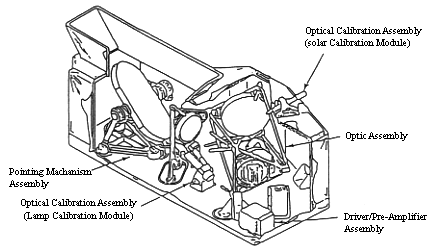
![[Prev Page]](http://www.eorc.nasda.go.jp/images/PrevPage.gif)
![[Next Page]](http://www.eorc.nasda.go.jp/images/NextPage.gif)
![[Top Of
Page]](http://www.eorc.nasda.go.jp/images/TopOfPage.gif)
![[ADEOS Home]](../../images/ADEOS_HomePage.gif)
![[EORC Home]](../../images/EORC_HomePage.gif)
![[Directory]](../../images/Directory.gif)
Advanced Visible and Near-Infrared Radiometer (AVNIR)
Observation Concept
Advanced Visible and Near-Infrared Radiometer (AVNIR) is an optical sensor for
measuring surface reflectance in 3 visible bands and 1 near-infrared band. The
three visible bands are indicated by blue, green and red while the near-infrared
band is suitable to observe vegetation. AVNIR has 4 multispectral bands of 16m
resolution and 1 panchromatic band of 8m resolution.
AVNIR scans about 80km swath width along the cross track, using the large
lineararray CCDs with 5,000 pixels (multispectral band) and 10,000 pixels
(panchromatic band).

|
| AVNIR Observation Concept
|
The observation area is limited because of narrow swath width. In order to
compensate this disadvantage, the pointing capability acquires the wide range of
target within +/- 40 degrees around the nadir. Similar to OCTS, AVNIR has
optical and electrical calibration functions so that sensitivity can be
monitored.
Planned Missions
AVNIR is a high resolution optical sensor for the wide range of the Earth
surface monitoring. The AVNIR data is used to understand vegetation and soil
conditions in order to contribute to solving such phenomena as desertification
and deforestation of tropical forests. In the land and urban utilization, the
observation data of artificial structures and plant distribution profile
contributes to creating better living environment. Other observation data such
as surface reflectance and radiance plays a key role in evaluation of energy
balance of the earth.
Given the fact that all the environmental issues have been addressed at the
local and regional levels, the AVNIR data with high resolution is valuable for
the global environment observation community.
Configuration and Specification of Sensor
AVNIR is composed of two units, the Scanning Radiometer Unit (SRU) which mainly
consists of optical components and the Electronic Unit (ELU) which mainly
processes the image data.

|
| AVNIR overview
|
The observation light is reflected by a pointing mirror with 0.5 degrees drive
angles. Optics in SRU adopts a Catadioptric Schimidt optical system as amirror
while spectrum is splitted into 4 multispectral bands and 1 panchromatic band
by combined effects of optical prism and interference filter.
After the optical signals are converted to electrical signals, Charged Coupled
Devices (CCDs) scan those signals and output to the ELU. As CCDs have a
capability of changing the integration time of the optical signals, sensitivity
can be well maintained even in the dark area.
The electrical signals are amplified in the Process Amplifier, and then
converted to the digital signals. The digital signals are processed in Image
Processing Assembly and transmitted to bus module. The multispectral observation
data is compressed by about 10% in order to reduce the transmission data rate.
![[Prev Page]](http://www.eorc.nasda.go.jp/images/PrevPage.gif)
![[Next Page]](http://www.eorc.nasda.go.jp/images/NextPage.gif)
![[Top Of
Page]](http://www.eorc.nasda.go.jp/images/TopOfPage.gif)
![[ADEOS Home]](../../images/ADEOS_HomePage.gif)
![[EORC Home]](../../images/EORC_HomePage.gif)
![[Directory]](../../images/Directory.gif)
 Earth Observation Research Center
Earth Observation Research Center
Comments to: adeossupport@eorc.nasda.go.jp
Last Update: 5 Febrary 1998




![]() Earth Observation Research Center
Earth Observation Research Center